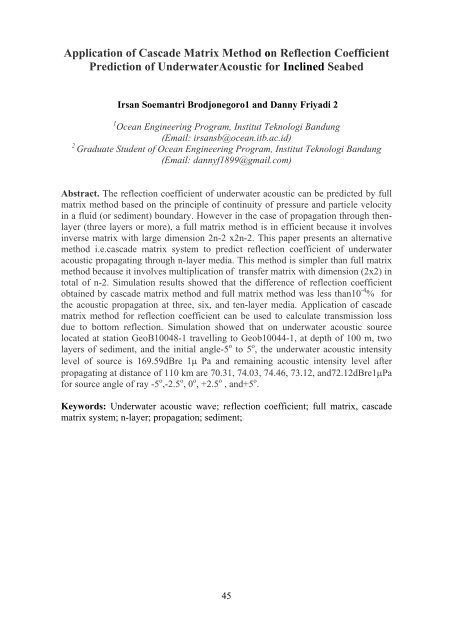Untitled - Teknik Kelautan / ITB
Untitled - Teknik Kelautan / ITB
Untitled - Teknik Kelautan / ITB
You also want an ePaper? Increase the reach of your titles
YUMPU automatically turns print PDFs into web optimized ePapers that Google loves.
Application of Cascade Matrix Method on Reflection Coefficient<br />
Prediction of UnderwaterAcoustic for Inclined Seabed<br />
Irsan Soemantri Brodjonegoro1 and Danny Friyadi 2<br />
1 Ocean Engineering Program, Institut Teknologi Bandung<br />
(Email: irsansb@ocean.itb.ac.id)<br />
2 Graduate Student of Ocean Engineering Program, Institut Teknologi Bandung<br />
(Email: dannyf1899@gmail.com)<br />
Abstract. The reflection coefficient of underwater acoustic can be predicted by full<br />
matrix method based on the principle of continuity of pressure and particle velocity<br />
in a fluid (or sediment) boundary. However in the case of propagation through thenlayer<br />
(three layers or more), a full matrix method is in efficient because it involves<br />
inverse matrix with large dimension 2n-2 x2n-2. This paper presents an alternative<br />
method i.e.cascade matrix system to predict reflection coefficient of underwater<br />
acoustic propagating through n-layer media. This method is simpler than full matrix<br />
method because it involves multiplication of transfer matrix with dimension (2x2) in<br />
total of n-2. Simulation results showed that the difference of reflection coefficient<br />
obtained by cascade matrix method and full matrix method was less than10 -4 % for<br />
the acoustic propagation at three, six, and ten-layer media. Application of cascade<br />
matrix method for reflection coefficient can be used to calculate transmission loss<br />
due to bottom reflection. Simulation showed that on underwater acoustic source<br />
located at station GeoB10048-1 travelling to Geob10044-1, at depth of 100 m, two<br />
layers of sediment, and the initial angle-5 o to 5 o , the underwater acoustic intensity<br />
level of source is 169.59dBre 1µ Pa and remaining acoustic intensity level after<br />
propagating at distance of 110 km are 70.31, 74.03, 74.46, 73.12, and72.12dBre1µPa<br />
for source angle of ray -5 o ,-2.5 o , 0 o , +2.5 o , and+5 o .<br />
Keywords: Underwater acoustic wave; reflection coefficient; full matrix, cascade<br />
matrix system; n-layer; propagation; sediment;<br />
45


